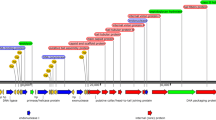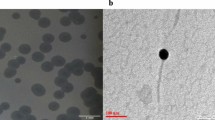Abstract
The increasing population infected by carbapenem-resistant Klebsiella pneumoniae necessitates the development of alternative therapies. In this study, we isolated, characterized, and sequenced a bacteriophage, P509, which was able to specifically infect and lyse carbapenem-resistant K. pneumoniae of K locus type KL64. A one-step growth curve experiment showed that the latent time period of phage P509 was 5 min, and the burst size was about 85 phage particles/cell. Stability tests confirmed that P509 was stable over a wide range of temperatures (4 to 50 °C) and pH (3 to 11) conditions. Phage P509 was identified as a linear double-stranded DNA phage with a genome of 40,954 bp with 53.2% G + C content, encoding 50 predicted proteins. Genomic and morphological analysis suggested that P509 belonged to the genus Przondovirus, family Autographiviridae, order Caudovirales. Further analysis showed that no virulence-related genes or lysogen-formation gene clusters were detected in the genome, suggesting that P509 is a lytic phage, making it potentially suitable for clinical applications. In vitro, the number of viable cells in three phage-treated groups (MOI = 0.1, 0.01, 0.001) decreased by 3.75 log10 CFU/ml, 3.32 log10 CFU/ml and 3.21 log10 CFU/ml, respectively, after 80 min of incubation, in comparison to that in the untreated group. Based on these characteristics, phage P509 may be a promising candidate for future phage therapy applications.



Similar content being viewed by others
Availability of data
The genome sequence of phage P509 was deposited in the GenBank database under accession number MT542697.
References
Podschun R, Ullmann U (1998) Klebsiella spp. as nosocomial pathogens: epidemiology, taxonomy, typing methods, and pathogenicity factors. Clin Microbiol Rev 11(4):489–603
Tsai FC, Huang YT, Chang LY, Wang JT (2008) Pyogenic liver abscess as endemic disease, Taiwan. Emerg Infect Dis 14(10):1592–1600. https://doi.org/10.3201/eid1410.071254
Ohmori S, Shiraki K, Ito K, Inoue H, Ito T, Sakai T, Takase K, Nakano T (2002) Septic endophthalmitis and meningitis associated with Klebsiella pneumoniae liver abscess. Hepatol Res 22(4):307–312. https://doi.org/10.1016/s1386-6346(01)00153-x
Xu L, Sun X, Ma X (2017) Systematic review and meta-analysis of mortality of patients infected with carbapenem-resistant Klebsiella pneumoniae. Ann Clini Microbiol Antimicrob 16(1):18. https://doi.org/10.1186/s12941-017-0191-3
Zhu WM, Yuan Z, Zhou HY (2020) Risk factors for carbapenem-resistant Klebsiella pneumoniae infection relative to two types of control patients: a systematic review and meta-analysis. Antimicrob Resist Infect Control 9(1):23. https://doi.org/10.1186/s13756-020-0686-0
Hsu CR, Lin TL, Pan YJ, Hsieh PF, Wang JT (2013) Isolation of a bacteriophage specific for a new capsular type of Klebsiella pneumoniae and characterization of its polysaccharide depolymerase. PloS One 8(8):e70092. https://doi.org/10.1371/journal.pone.0070092
Pan YJ, Lin TL, Lin YT, Su PA, Chen CT, Hsieh PF, Hsu CR, Chen CC, Hsieh YC, Wang JT (2015) Identification of capsular types in carbapenem-resistant Klebsiella pneumoniae strains by wzc sequencing and implications for capsule depolymerase treatment. Antimicrob Agents Chemother 59(2):1038–1047. https://doi.org/10.1128/AAC.03560-14
Pan YJ, Lin TL, Chen YH, Hsu CR, Hsieh PF, Wu MC, Wang JT (2013) Capsular types of Klebsiella pneumoniae revisited by wzc sequencing. PloS One 8(12):e80670. https://doi.org/10.1371/journal.pone.0080670
Pan YJ, Fang HC, Yang HC, Lin TL, Hsieh PF, Tsai FC, Keynan Y, Wang JT (2008) Capsular polysaccharide synthesis regions in Klebsiella pneumoniae serotype K57 and a new capsular serotype. J Clin Microbiol 46(7):2231–2240. https://doi.org/10.1128/JCM.01716-07
Li B, Zhao Y, Liu C, Chen Z, Zhou D (2014) Molecular pathogenesis of Klebsiella pneumoniae. Future Microbiol 9(9):1071–1081. https://doi.org/10.2217/fmb.14.48
Zhao X, Cui Y, Yan Y, Du Z, Tan Y, Yang H, Bi Y, Zhang P, Zhou L, Zhou D, Han Y, Song Y, Wang X, Yang R (2013) Outer membrane proteins ail and OmpF of Yersinia pestis are involved in the adsorption of T7-related bacteriophage Yep-phi. J Virol 87(22):12260–12269. https://doi.org/10.1128/JVI.01948-13
Fan F, Li X, Pang B, Zhang C, Li Z, Zhang L, Li J, Zhang J, Yan M, Liang W, Kan B (2018) The outer-membrane protein TolC of Vibrio cholerae serves as a second cell-surface receptor for the VP3 phage. J Biol Chem 293(11):4000–4013. https://doi.org/10.1074/jbc.M117.805689
Porcek NB, Parent K N (2015) Key residues of S flexneri OmpA mediate infection by bacteriophage Sf6. J Mol Biol 427(10):194–196. https://doi.org/10.1016/j.jmb.2015.03.012
Pan YJ, Lin TL, Chen CC, Tsai YT, Cheng YH, Chen YY, Hsieh PF, Lin YT, Wang JT (2017) Klebsiella Phage PhiK64-1 Encodes Multiple Depolymerases for Multiple Host Capsular Types. J Virol. https://doi.org/10.1128/jvi.02457-16
Wu Y, Wang R, Xu M, Liu Y, Zhu X, Qiu J, Liu Q, He P, Li Q (2019) A novel polysaccharide depolymerase encoded by the phage SH-KP152226 confers specific activity against multidrug-resistant Klebsiella pneumoniae via biofilm degradation. Front Microbiol 10:2768. https://doi.org/10.3389/fmicb.2019.02768
Lin TL, Hsieh PF, Huang YT, Lee WC, Tsai YT, Su PA, Pan YJ, Hsu CR, Wu MC, Wang JT (2014) Isolation of a bacteriophage and its depolymerase specific for K1 capsule of Klebsiella pneumoniae: implication in typing and treatment. J Infect Dis 210(11):1734–1744. https://doi.org/10.1093/infdis/jiu332
Hsieh PF, Lin HH, Lin TL, Chen YY, Wang JT (2017) Two T7-like bacteriophages, K5-2 and K5-4, each encodes two capsule depolymerases: isolation and functional characterization. Sci Rep 7(1):4624. https://doi.org/10.1038/s41598-017-04644-2
Wang C, Li P, Niu W, Yuan X, Liu H, Huang Y, An X, Fan H, Zhangxiang L, Mi L, Zheng J, Liu Y, Tong Y, Mi Z, Bai C (2019) Protective and therapeutic application of the depolymerase derived from a novel KN1 genotype of Klebsiella pneumoniae bacteriophage in mice. Res Microbiol 170(3):156–164. https://doi.org/10.1016/j.resmic.2019.01.003
Li M, Guo M, Chen L, Zhu C, Xiao Y, Li P, Guo H, Chen L, Zhang W, Du H (2020) Isolation and characterization of novel lytic bacteriophages infecting epidemic carbapenem-resistant Klebsiella pneumoniae strains. Front Microbiol. https://doi.org/10.3389/fmicb.2020.01554
Adams M (1959) Bacteriophage. Interscience Publishers, New York
Gu J, Xu W, Lei L, Huang J, Feng X, Sun C, Du C, Zuo J, Li Y, Du T, Li L, Han W (2011) LysGH15, a novel bacteriophage lysin, protects a murine bacteremia model efficiently against lethal methicillin-resistant Staphylococcus aureus infection. J Clin Microbiol 49(1):111–117. https://doi.org/10.1128/JCM.01144-10
Mirzaei MK, Nilsson AS (2015) Correction: Isolation of phages for phage therapy: a comparison of spot tests and efficiency of plating analyses for determination of host range and efficacy. PloS One 10(5):e0127606. https://doi.org/10.1371/journal.pone.0127606
Ji Y, Cheng M, Zhai S, Xi H, Cai R, Wang Z, Zhang H, Wang X, Xue Y, Li X, Sun C, Feng X, Lei L, Ur Rahman S, Han W, Gu J (2019) Preventive effect of the phage VB-SavM-JYL01 on rabbit necrotizing pneumonia caused by Staphylococcus aureus. Vet Microbiol 229:72–80. https://doi.org/10.1016/j.vetmic.2018.12.021
Gong P, Cheng M, Li X, Jiang H, Yu C, Kahaer N, Li J, Zhang L, Xia F, Hu L, Sun C, Feng X, Lei L, Han W, Gu J (2016) Characterization of Enterococcus faecium bacteriophage IME-EFm5 and its endolysin LysEFm5. Virology 492:11–20. https://doi.org/10.1016/j.virol.2016.02.006
Pajunen M, Kiljunen S, Skurnik M (2000) Bacteriophage phiYeO3-12, specific for Yersinia enterocolitica serotype O:3, is related to coliphages T3 and T7. J Bacteriol 182(18):5114–5120. https://doi.org/10.1128/jb.182.18.5114-5120.2000
Laemmli UK (1970) Cleavage of structural proteins during the assembly of the head of bacteriophage T4. Nature 227(5259):680–685
Sambrook J, Russell DW (2006) Precipitation of Bacteriophage lambda Particles from Large-scale Lysates. CSH Protoc. https://doi.org/10.1101/pdb.prot3966
Bankevich A, Nurk S, Antipov D, Gurevich AA, Dvorkin M, Kulikov AS, Lesin VM, Nikolenko SI, Pham S, Prjibelski AD, Pyshkin AV, Sirotkin AV, Vyahhi N, Tesler G, Alekseyev MA, Pevzner PA (2012) SPAdes: a new genome assembly algorithm and its applications to single-cell sequencing. J Comput Biol 19(5):455–477. https://doi.org/10.1089/cmb.2012.0021
Aziz RK, Bartels D, Best AA, DeJongh M, Disz T, Edwards RA, Formsma K, Gerdes S, Glass EM, Kubal M, Meyer F, Olsen GJ, Olson R, Osterman AL, Overbeek RA, McNeil LK, Paarmann D, Paczian T, Parrello B, Pusch GD, Reich C, Stevens R, Vassieva O, Vonstein V, Wilke A, Zagnitko O (2008) The RAST server: rapid annotations using subsystems technology. BMC Genomics 9:75. https://doi.org/10.1186/1471-2164-9-75
Shi Y, Chen Y, Yang Z, Zhang Y, You B, Liu X, Chen P, Liu M, Zhang C, Luo X, Chen Y, Yuan Z, Chen J, Gong Y, Peng Y (2020) Characterization and genome sequencing of a novel T7-like lytic phage, kpssk3, infecting carbapenem-resistant Klebsiella pneumoniae. Arch Virol 165(1):97–104. https://doi.org/10.1007/s00705-019-04447-y
Tan D, Zhang Y, Cheng M, Le S, Gu J, Bao J, Qin J, Guo X, Zhu T (2019) Characterization of Klebsiella pneumoniae ST11 isolates and their interactions with lytic phages. Viruses. https://doi.org/10.3390/v11111080
Mahichi F, Synnott AJ, Yamamichi K, Osada T, Tanji Y (2009) Site-specific recombination of T2 phage using IP008 long tail fiber genes provides a targeted method for expanding host range while retaining lytic activity. FEMS Microbiol Lett 295(2):211–217. https://doi.org/10.1111/j.1574-6968.2009.01588.x
Funding
This study was supported by grants from the National Natural Science Foundation of China (U1803109), National Key R&D Program of China (2018YFC1602500), University-Level Science and Technology Team of Wuhu Institute of Technology (wzykjtd202002), Key Research and Development Project of Jiangsu Provincial Science and Technology Department (BE2017654), Gusu Key Health Talent of Suzhou, Jiangsu Youth Medical Talents Program (QN-867), and the Science and Technology Program of Suzhou (SZS201715).
Author information
Authors and Affiliations
Contributions
All authors contributed to the conception and design of the study. ML, YX, PL, ZW, WQ and ZQ performed experiments and computational analysis. ML wrote the first draft of the manuscript. All authors read, revised, and approved the final manuscript.
Corresponding author
Ethics declarations
Conflict of interest
The authors declare that they have no conflict of interest.
Animal and human rights statement
This article does not contain any studies with human participants or animals performed by any of the authors.
Additional information
Handling Editor: T. K. Frey.
Publisher's Note
Springer Nature remains neutral with regard to jurisdictional claims in published maps and institutional affiliations.
Electronic supplementary material
Below is the link to the electronic supplementary material.
Rights and permissions
About this article
Cite this article
Li, M., Xiao, Y., Li, P. et al. Characterization and genome analysis of Klebsiella phage P509, with lytic activity against clinical carbapenem-resistant Klebsiella pneumoniae of the KL64 capsular type. Arch Virol 165, 2799–2806 (2020). https://doi.org/10.1007/s00705-020-04822-0
Received:
Accepted:
Published:
Issue Date:
DOI: https://doi.org/10.1007/s00705-020-04822-0




